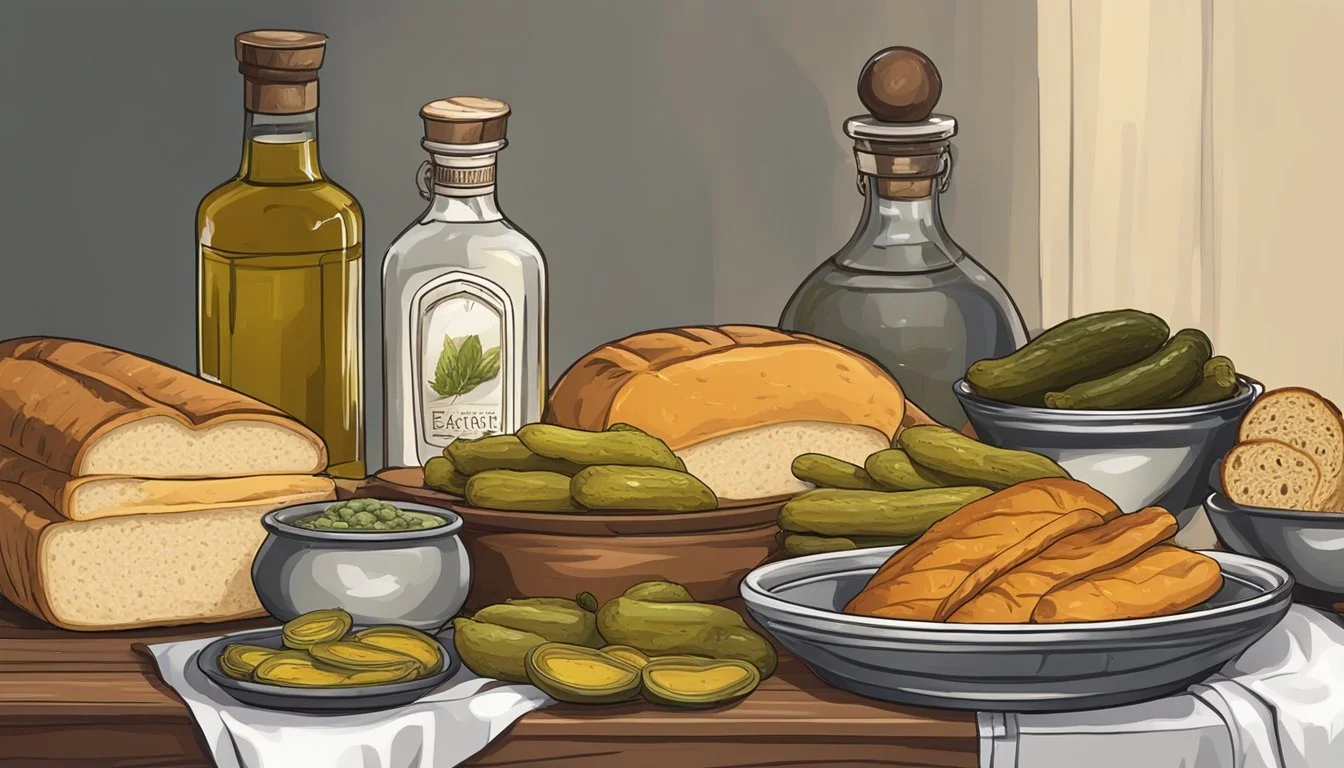Salo Unveiling Eastern Europe's Cherished Cured Fatback Tradition
Salo, the cured back fat of a pig, is a distinctive culinary tradition deeply entrenched in Eastern European culture, particularly in Ukraine. Characterized by its high fat content, salo is often compared to uncooked bacon, though it stands apart due to its unique consumption methods which commonly involve eating raw or slightly smoked, rather than fried. This rich, savory delicacy is not just a food item but a symbol of hospitality and an essential component of social gatherings, reflecting the region's history and the resourcefulness of its people in preserving food.
Traditionally, salo is made by curing slabs of pork subcutaneous fat with or without the skin. The curing process typically involves salt, and sometimes additional spices like garlic, black pepper, coriander, and paprika to enhance flavor. In Eastern European countries, especially in Ukraine, salo is regarded as more than a simple snack; it encapsulates a part of the national identity and is often celebrated at festivals and culinary events.
In the context of Eastern European gastronomy, salo's versatility is evident in its various forms of preparation and presentation. While some prefer it thinly sliced and served with rye bread and mustard, others may savor it as part of more elaborate dishes or use it in cooking to add depth to flavors. Despite its simplicity, salo's ability to evoke a sense of place and tradition renders it a cultural staple that endures in the culinary landscape of Eastern Europe.
Historical Significance
Salo has been a vital component of Eastern European culinary traditions for centuries, closely interwoven with the region's social and cultural fabric.
Salo in Eastern European Tradition
In Eastern Europe, particularly within Slavic cultures, salo is not merely a food item but a historical staple. Its origins span back to times when food preservation was essential for survival through harsh winters. In these communities, every part of a pig was used, reflecting a tradition of resourcefulness and respect for the animal. Salo, the cured back fat of pigs, was favored for its long shelf life and versatility. It commonly features in regional festive dishes and day-to-day cuisine, symbolizing a connection to the land and the past.
Cultural Role in Ukraine and Slavic Regions
The savoring of salo runs deepest in Ukraine, where it is cherished as a national delicacy and a symbol of cultural identity. It has played a significant role in reinforcing national pride, especially in the face of past Russian influence and during periods of political tension. In Slavic regions, salo is often the center of social gatherings and culinary celebrations, due in part to its historical use as an accessible source of energy for agricultural communities. Throughout these regions, humor and folklore often revolve around salo, further cementing its place in the collective cultural consciousness.
Culinary Importance
Salo plays a significant role in Eastern European culinary traditions, serving both as a symbol of cultural identity and as a staple ingredient in numerous dishes. It is particularly renowned for its versatility in cooking and its ability to enhance flavors.
Salo in Ukrainian Cuisine
In Ukrainian cuisine, salo is more than just food; it's a revered component of the nation's culinary heritage. It is commonly cured with salt and can feature a variety of other spices like black pepper, garlic, and paprika, depending on regional preferences. Ukrainians often consume salo raw, lightly salted, or smoked, and it can be found in a vast array of traditional dishes, from simple starters to hearty main courses.
National Dishes Featuring Salo
Salo prominently features in several national dishes across Ukraine. For example:
Borshch: Often accompanied by a slice of salo, this beet soup highlights its flavor-enhancing properties.
Varenyky: These dumplings sometimes include bits of salo as filling, providing a rich taste and texture contrast.
Salo Across Eastern European Gastronomy
Beyond Ukraine, salo holds a place in the broader Eastern European gastronomic landscape. Each country and region has its own variant of salo, with nuances in preparation and seasoning. The product has transcended Ukrainian borders and is available in various forms in restaurants and homes throughout Eastern Europe, celebrated for its ability to preserve for an extended period and its essential role in traditional cooking methods.
Production and Varieties
Salo, a traditional Eastern European cured pork fatback, is valued for its preservation process and rich taste. This delicacy undergoes curing and sometimes smoking, with varieties that reflect the culinary practices of different regions.
Traditional Methods of Preparing Salo
The production of Salo begins with the selection of high-quality pork fatback. It is typically cured with salt, either by dry curing or wet brining. The curing process can last from several days to months, depending on the desired flavor intensity and texture. Once cured, Salo may be left as is or further processed through smoking. Smoking not only imparts a distinctive flavor but also extends the delicacy's shelf life. Salo that is ready for consumption may be cut into slabs or cubes.
Curing with Salt: At least a week in a cool, ventilated area.
Further Smoking: Optional step for enhanced flavor, involves beech or oak wood.
Regional Variations of Salo
Salo displays a variety of regional adaptations, influenced by cultural preferences and available resources. Spices and smoking methods introduce a range of flavors and textures. Varieties include the Hungarian slanina, which may be aged in paprika, and variants found in countries like Bulgaria, Romania, and Poland, where it's known as slanina or slănină. Each region brings its own twist:
Ukraine: Often spiced with black pepper, garlic, and sometimes bay leaves.
Hungary: Aged with paprika, creating a unique color and flavor.
Romania and Bulgaria: May include a variety of spices like pepper or garlic.
The availability of these varieties in local and international markets reflects not only Salo's cultural significance but also its versatility and appeal as a food product.
Consumption Practices
In Eastern European cuisine, salo holds a significant cultural and gastronomic position, representing more than just a food item; it reflects a rich tradition and ingenuity in preserving meat. This section explores how salo is integrated into daily diets and accompanying dishes.
Salo as a Staple Food
Salo is revered in Eastern Europe, particularly in Ukraine, as a pivotal dietary element. It is traditionally non-rendered pork fatback that is cured through processes such as dry-salting, brining, or even boiling. Historically, it served as a robust energy source and was especially valuable in cold climates and for labor-intensive work due to its high caloric content. Salo was often consumed in thin slices and appreciated for its ability to be stored for long periods, proving essential in times when fresh produce was scarce.
Salo in Modern Day Diet
In the modern context, salo remains part of the Eastern European diet albeit in moderation. It is considered neither specifically healthy nor entirely unhealthy, but rather a traditional food to be enjoyed in balance. Consumption has adapted to contemporary dietary habits, and salo is now more typically enjoyed as a flavorful snack, often chopped or ground into small pieces and added to dishes for additional savory notes. The use of salo has transitioned from necessity to culinary preference, where it adds depth to various recipes and maintains its cultural heritage.
Customary Accompaniments for Salo
Salo is rarely eaten on its own; it is usually paired with simple, staple food items. The most traditional accompaniments for salo include:
Bread: A slice of hearty, whole grain bread serves as an ideal base for thin slices of salo, highlighting its bold flavors.
Potatoes: Whether boiled, fried, or mashed, potatoes complement the richness of salo and are a common side dish.
Vegetarian Additions: Although salo is a meat product, it is often paired with fresh vegetables like onions, radishes, or pickles, which can cut through the fat and refresh the palate.
Cooked versions, like small fried pieces of salo called "shkvarki," are enjoyed atop regional dishes such as borscht or alongside fried potatoes. This rich, cultural fatback continues to be an intrinsic part of the Eastern European diet, revered for its versatility and the traditional value it embodies.
Health and Nutrition
In discussing Salo's health and nutrition aspects, it is important to objectively assess its nutritional value while also addressing common misconceptions surrounding fat consumption.
Nutritional Value of Salo
Salo, essentially cured pork fatback, is rich in nutrients vital for human health. In contrast to common belief, not all fats are detrimental to health, and in fact, some are quite necessary. Salo primarily consists of monounsaturated and saturated fats, which play diverse roles in the body, from constructing cell membranes to supporting cardiovascular health.
Key Nutritional Components in 100g of Salo:
Calories: Approximately 700 kcal
Total fat: Around 80g
Saturated fat: Significant percentage of the total fats
Monounsaturated fat: Present in lower amounts
Cholesterol: Moderate amount
Minerals: Salo contains trace minerals essential for body functions.
Debunking Myths About Fat Consumption
The consumption of fats, such as those found in Salo, is often misunderstood, leading to several myths that deserve clarification. It’s important to distinguish between different types of fats; while trans fats are unequivocally harmful, contributing to heart disease, the fats present in Salo do not fall within this detrimental category.
Monounsaturated fats can be beneficial when they replace saturated fats in the diet.
Saturated fats, though required in moderation, should not be entirely excluded, as they are necessary for the production of certain hormones and for the absorption of fat-soluble vitamins.
One must consider the moderation and balance of fat intake within the broader context of a healthy diet. It is essential to understand that while Salo can be a part of a balanced diet, its consumption should be circumspect, considering its high-caloric nature and fat content. Nutritionists advise that it is not the sole type of fat one should consume, and it is crucial to combine it with a variety of other nutrient sources for a well-rounded diet.
Salo in Festive and Ritual Contexts
Salo, the cured pork fatback, is more than just a food item in Eastern European culture—it often plays a significant role in various celebrations and rituals, particularly during Easter and wedding festivities.
Easter Celebrations and Salo
In Eastern European countries such as Ukraine, the period of Easter marks a significant cultural and religious event where Salo features prominently. This period is marked by Paskha, a rich, festive spread:
Symbolism: Salo is often included on the Sviachene, the traditional Easter table, symbolizing wealth and prosperity.
Culinary Tradition: As Easter follows the Lenten fast, Salo serves not only as a rich treat but as a fulfilling and high-energy food to break the fast.
Families typically cure and prepare Salo in advance, flavoring it with traditional spices like garlic and black pepper, and it is often enjoyed with rye bread, hard-boiled eggs, and horseradish.
Weddings and Feasts
Salo also has a distinctive role in wedding ceremonies and feasts across Eastern Europe, where it is considered an essential part of the celebration:
Welcoming the Guests: At weddings, Salo is often used in the hospitality ritual, where slices of Salo, alongside bread and salt, are offered to guests as a sign of welcome and generosity.
Culinary Feature: During the wedding feast, Salo is typically served as an appetizer, showcasing the host's commitment to traditional cuisine and the importance of Salo in celebratory banquets.
Incorporating Salo into these events not only reflects culinary practices but also emphasizes deep-rooted customs that are integral to Eastern European culture.
Salo in the Arts and Literature
Salo has not only been a significant part of Eastern European culinary culture, but it has also permeated the realms of art and literature, reflecting its cultural importance in various creative expressions.
Depictions of Salo in Art
Artists have occasionally featured salo in their work to capture the essence of Ukrainian life and heritage. Still life paintings sometimes include salo as a symbol of sustenance and a connection to Ukrainian peasant roots. In modern installations and contemporary art, salo has been used metaphorically to invoke discussions on Ukrainian identity and the complexities of post-Soviet society.
Literary References to Salo
In Ukrainian literature, salo often appears as a motif to underscore Ukrainian identity and tradition. Notably, salo is referenced in narratives that evoke the rustic charm of Ukrainian villages, showcasing the simplicity and earthiness of rural life. Furthermore, humor and satire involving salo in literature serve as a means to tackle deeper social issues within Ukrainian culture. Salo's prevalence in literature underlines its role as a cultural touchstone and its ubiquitous place at the heart of Ukrainian heritage.
Contemporary Perspectives
In the landscape of culinary tradition and modern cuisine, salo occupies a unique position, reaffirming its cultural significance in Eastern Europe while adapting to contemporary tastes and cooking practices.
The Revival of Traditional Foods
Salo, as a traditional Eastern European food, has seen a resurgence in popularity due to the growing appreciation for regional and heritage cuisine. Markets across Ukraine and Eastern Europe have experienced an increase in demand for high-quality, artisanal salo. This revival is part of a larger trend where consumers seek out authentic food experiences and show a renewed interest in the culinary practices of their ancestors.
Artisanal Salo:
Quality: Emphasis on traditional curing methods to ensure premium taste
Variety: Introduction of flavors with local herbs and spices
Source: Preference for locally sourced pork demonstrating a farm-to-table ethos
Salo's Place in Modern Gastronomy
Modern gastronomy has embraced salo, incorporating it into contemporary dishes that honor its heritage while innovating its use. Chefs in upscale restaurants have been key players in salo's revival, using it to add depth to dishes and creating fusion cuisine that bridges Eastern European flavors with global culinary trends.
In Cooking:
Texture and Flavor: Utilized for its unique texture and ability to impart richness
Fusion Cuisine: Combined with international ingredients to create new experiences
Salo's versatility in cooking, from traditional recipes to cutting-edge culinary creations, underscores its enduring appeal and adaptability in the ever-evolving landscape of food.
Salo and Tourism
Salo, the cured pork fatback that's a cherished part of Eastern European culinary heritage, notably in Ukraine, has become an intriguing aspect of regional tourism. From festive events celebrating this staple to specialized food tours centering on salo, tourists can immerse themselves in the cultural significance and flavors of this unique delicacy.
Salo-Themed Festivals
Ukraine hosts Salo-themed festivals where this traditional food is celebrated in various forms and preparations. One of the most famous events is the 'With Love To Salo' festival in Lviv, which has become a major draw for tourists. This festival has made a mark by setting records such as creating a 76-meter long salo sandwich. Through these festivals, visitors not only sample a wide array of salo-based dishes but also engage in cultural activities that highlight the importance of salo in Ukrainian culture.
Food Tours and Salo
Food tours prominently featuring salo provide tourists a pathway to explore Eastern European cuisine. Such tours highlight:
Lviv: Known for its rich culinary scene, with restaurants offering traditional salo and a variety of other local dishes.
Museums: Some tours include visits to museums where guests can learn about the history and production of salo.
Through these experiences, travelers gain a deeper understanding of salo's place in Ukraine’s gastronomy and the significance of this fatty delicacy in sustaining the culinary traditions of Eastern Europe.










